New!
Take a tour of our laboratories through this 3D-map of the Femtoscience and Microscopy Labs of Professor Abderrazzak Douhal Alaui Group´s at the Faculty of Environmental Sciences and Biochemistry and INAMOL, at the technology campus of the University of Castilla la Mancha (UCLM), Toledo.
Visítanos a través de este mapa 3D de los laboratorios de Femtociencia y Microscopia dirigidos por el Prof. Abderrazzak Douhal Alaui (catedrático de Universidad) en la Facultad de Ciencias Ambientales y Bioquímica y el Instituto de Nanociencia Nanotecnología Molecular (INAMOL) en el campus de tecnológico de la Universidad de Castilla la Mancha (UCLM), Toledo.
Laboratories
The laboratories are located at the Institute INAMOL, at the "Campus Tecnológico de Toledo, Spain". The labs are equipped with fs to ns laser based spectroscopy (emission and UV-visible transient absorption techniques and time-resolved single-molecule fluorescence microscopy).
The current research is focused on explaining the spectroscopic and photodynamic properties of Metal/Covalent/Hydrogen-bonded Organic Frameworks (MOFs, COFs and HOFs) and related hybrid materials containing different organic fluorophores and interacting with different molecules. Morevoer, we are also focused on photo-induced proton-, charge (electron)- and energy-transfer reactions and internal rotation in aromatic molecules, including drugs, in condensed phase and confined within chemical and biological nanocavities and nanochannels, relevant to nanoscience (nanomedicine, nanophotonics, and nanocatalysis). But, we are also elucidating the electron and hole dynamics in perovskite and QDs-Perovskite hybrid materials, using fs-uv- and IR transient absorption and fs-THz time resolved techniques.
The laboratories are located at the Institute INAMOL, at the "Campus Tecnológico de Toledo, Spain". The labs are equipped with fs to ns laser based spectroscopy (emission and UV-visible transient absorption techniques and time-resolved single-molecule fluorescence microscopy).
The current research is focused on explaining the spectroscopic and photodynamic properties of Metal/Covalent/Hydrogen-bonded Organic Frameworks (MOFs, COFs and HOFs) and related hybrid materials containing different organic fluorophores and interacting with different molecules. Morevoer, we are also focused on photo-induced proton-, charge (electron)- and energy-transfer reactions and internal rotation in aromatic molecules, including drugs, in condensed phase and confined within chemical and biological nanocavities and nanochannels, relevant to nanoscience (nanomedicine, nanophotonics, and nanocatalysis). But, we are also elucidating the electron and hole dynamics in perovskite and QDs-Perovskite hybrid materials, using fs-uv- and IR transient absorption and fs-THz time resolved techniques.
|
Flash-Photolysis Spectroscopy
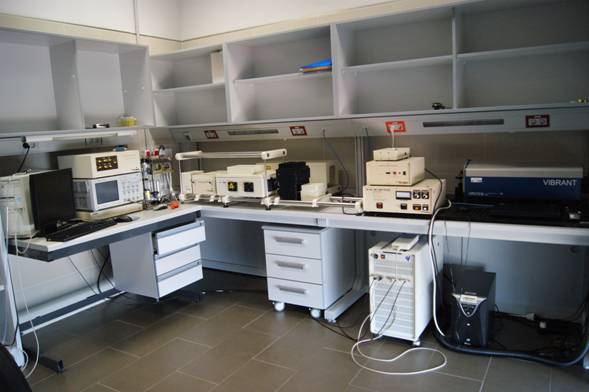
|
Time Correlated Single Photon Counting, with a time-resolution of 10 ps
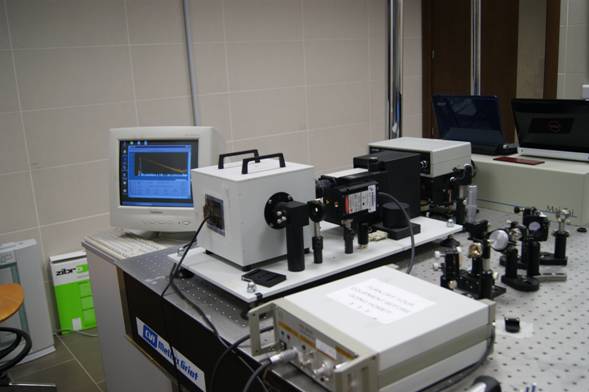
|
|
UV/vis pump-probe transient absorption/transmission
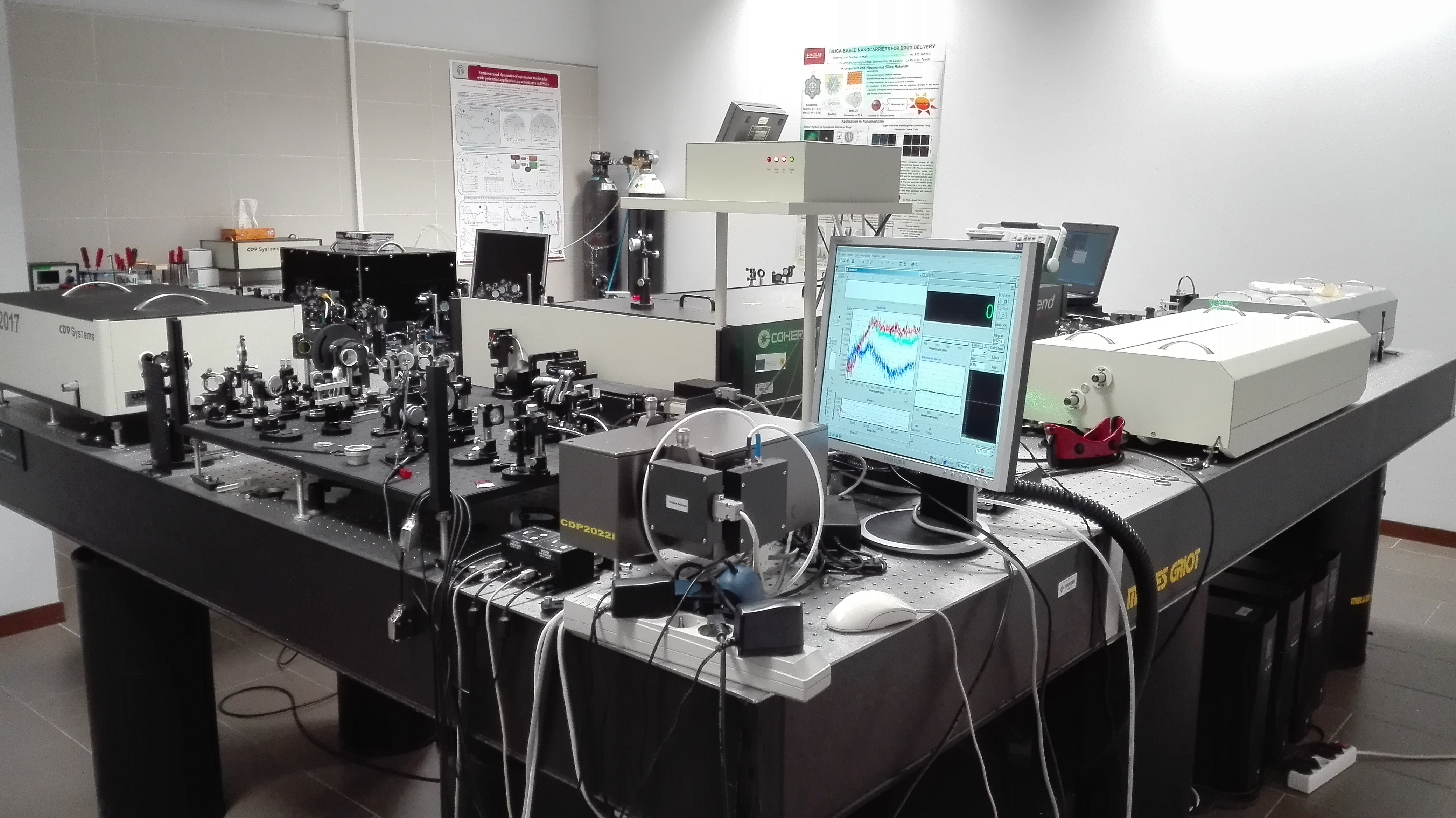
|
Up-conversion emission spectroscopy
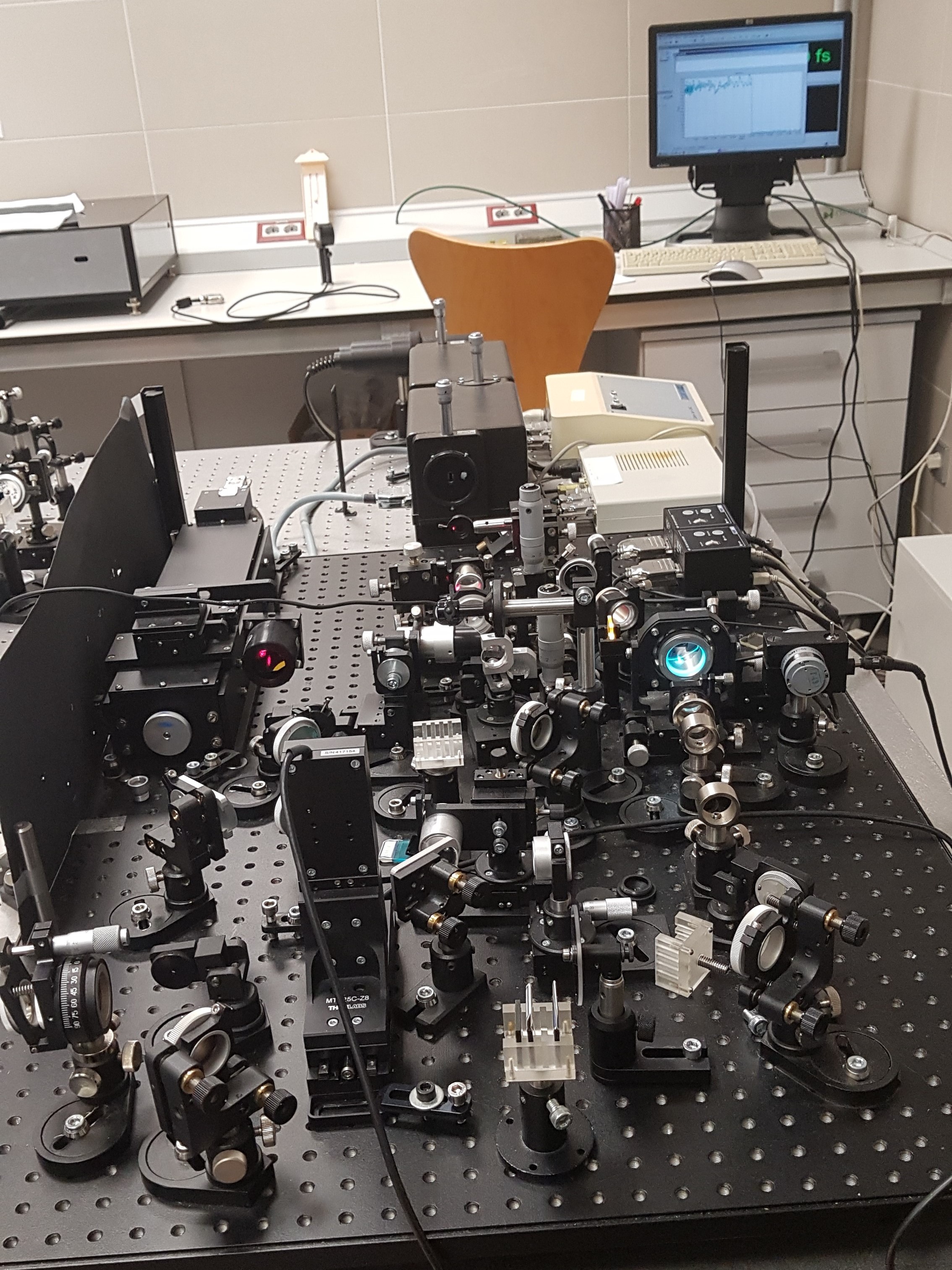
|
|
THz time-resolved spectroscopy
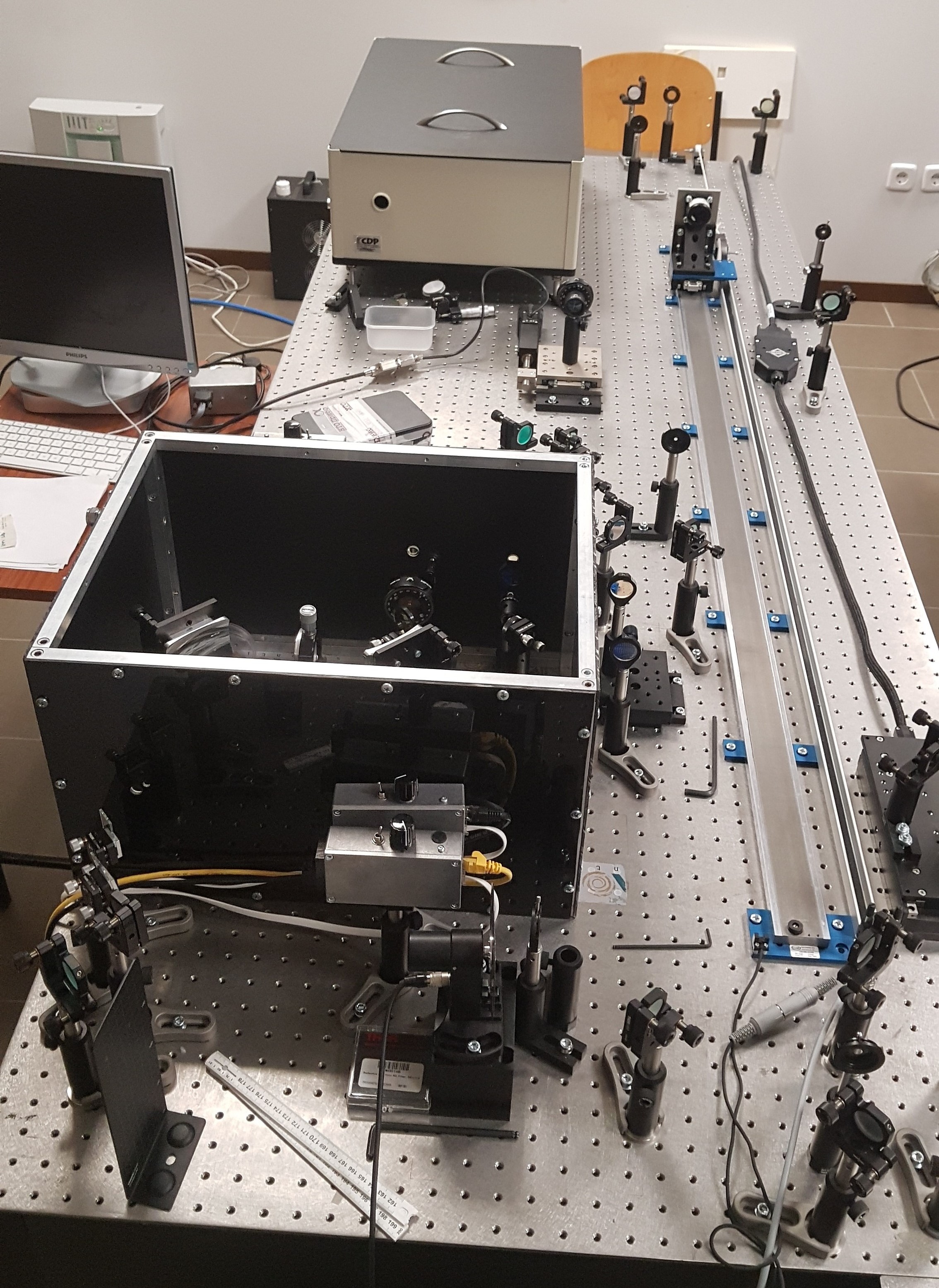
|
Single molecule/crystal fluorescence microscopy resolved in space and time
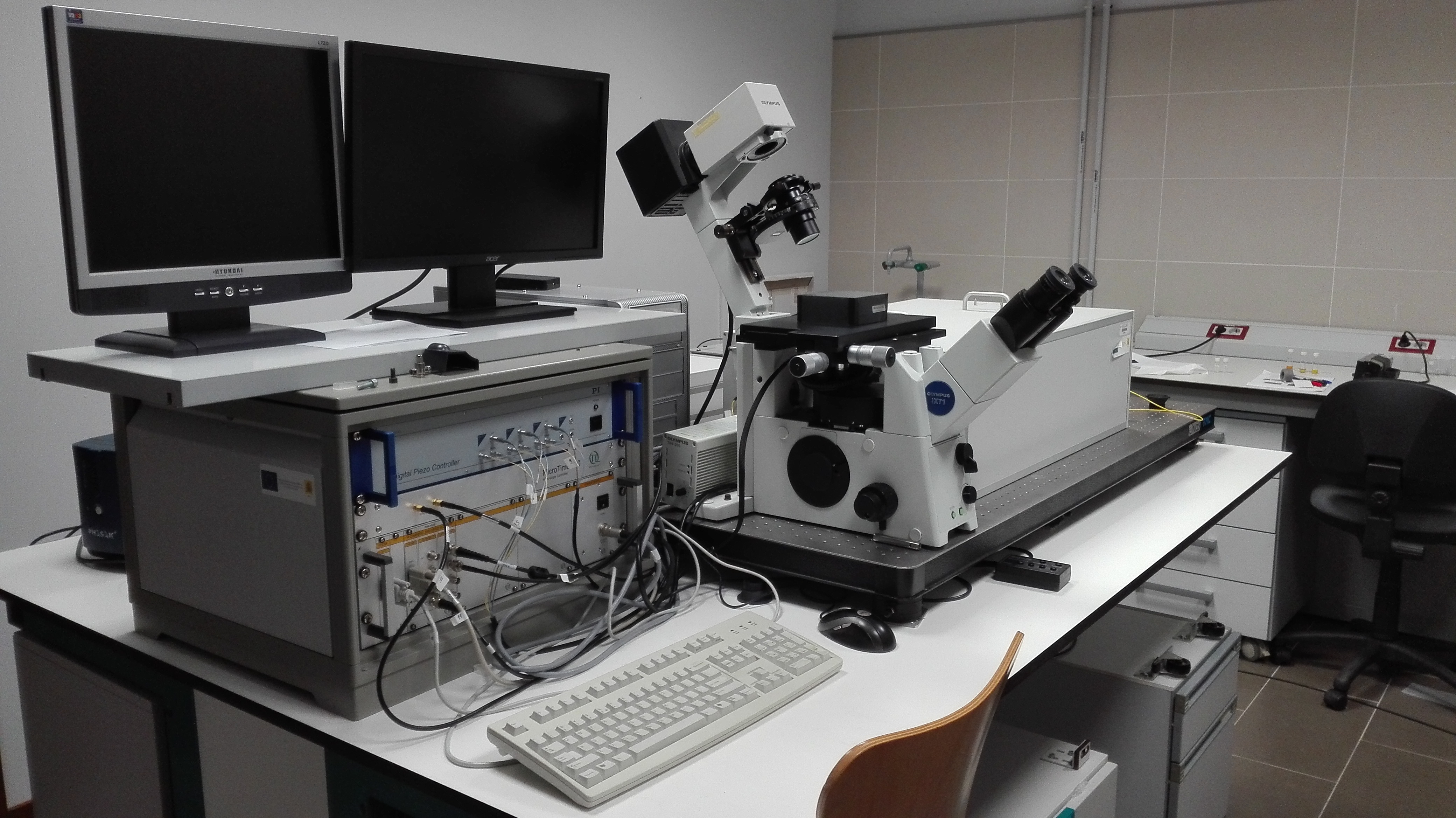
|
|
Synthesis Lab: Making MOFs and QDs

|
|
- Time-correlated single-photon counting (TCSPC), with a time-resolution of 10 ps. This technique provides information on the emission lifetimes of the excited systems in the ps-ns time scale, together with anisotropy decay times. For excitation, we can use fs or ps laser beams from 320 to 800 nm.
- Flash-photolysis spectroscopy. The system allows the measurement of transient UV-visible-IR spectra and ns-ms decays in solution, suspensions and solid state. The instrument consists of a laser (7 ns), monochromator and a detector, which registers the changes in the ns-s transient absorption spectra using a xenon flash lamp in the range of 250-2000 nm.
- Up-conversion emission spectroscopy. The experimental setup provides ~ 90 fs pulses in the spectral range of 350-1090 nm. The technique allows studying the dynamics of the excited state from tens of fs to hundreds of ps of liquids, suspensions and solid samples. Anisotropy experiments can be performed to get insight on the dipole moment re-orientation of the excited system in real time.
- THz time-resolved spectroscopy. Terahertz time-domain spectroscopy (THz-TDS) is a technique probing simultaneously far infrared radiation (1THz ~ 33 cm–1) absorption and dephasing. These energies are much lower than electronic transitions in molecules, atoms and semiconductors but correspond typically to low frequency vibrations in molecules and materials as well as the typical scattering frequencies of charge carriers in semiconductors. For these reasons, THz-TDS is a suitable technique to investigate photoinduced charge transport phenomena in complex chemical and biological systems. Combined with an ultrafast excitation pulse in an optical pump-THz probe (OPTP) scheme, the technique allows studying photogenerated charge carriers and low-frequency molecular vibrations dynamics with sub-ps time-resolution up to ns window of observation, making it an ideal powerful and complementary tool for investigating primary light-induced events in semiconductors. Direct information on excitons and charge carriers dynamics can be extracted at different wavelengths of excitation and pump fluencies. We can excite solid (films) samples from 300 to 1000 nm, and gate from 10´s of fs to 10 ns, which makes the system more interesting.
- UV/vis pump-probe transient absorption/transmission. The experimental setup allows to follow the real-time dynamics of the excited systems by monitoring the transient absorption spectra and decays of the excited species from tens of fs to 2 ns. The system, which is equipped with an optical parametric amplifier, provides laser pulses of tens of fs in the spectral range of 240 – 2200 nm. The time resolution of the setup is about 50 fs. The sample can be liquid or solid/polymer. The detection system operates with a femtosecond continuum probe up to 1150 nm.
- Single molecule/crystal fluorescence microscopy resolved in space and time (SMS). It provides emission lifetimes and spectra of a single molecule, particle or crystal, on-off behaviour, steady-state and time-resolved polarization and anisotropy, and inter-photon arrival times of individual molecules in different environments. This technique needs very small amounts of sample, but due to its high sensitivity, the samples and the environment must be extremely pure and stable for the duration of the experiment. The available ps-lasers for excitation of the system are: 371, 390, 430, 470 and 635 nm, in addition to use of a fs beam at a desired wavelength and power. The IRF is about 250 ps, and the speacial resolution is about 300 nm.